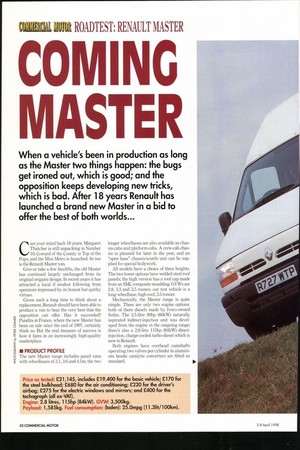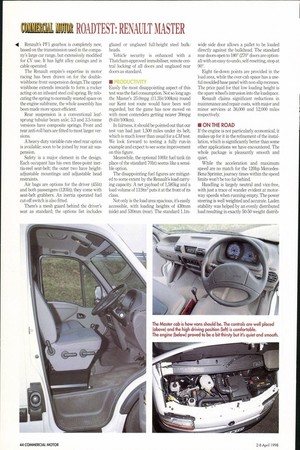COMING MASTER When a vehicle's been in production as long
Page 44

Page 46

Page 47

Page 48

If you've noticed an error in this article please click here to report it so we can fix it.
as the Master two things happen: the bugs get ironed out, which is good; and the opposition keeps developing new tricks, which is bad. After 18 years Renault has launched a brand new Master in a bid to offer the best of both worlds...
Price as tested: £21,145, includes £19,400 for the basic vehicle; £170 for the steel bulkhead; £680 for the air conditioning; £220 for the driver's airbag; £275 for the electric windows and mirrors; and £400 for the tachograph (all ex-VAT).
Engine: 2.8 litres, 115hp (84kW). GVVV. 3,500kg. Payload: 1,585kg. Fuel consumption: (laden): 25.0mpg (11.311t/100km). Cast your mind back 18 years. Margaret Thatcher is still unpacking in Number 10; Coward of the County is Top of the Pops; and the Mini Metro is launched. So too is the Renault Master van.
Give or take a few facelifts, the old Master has continued largely unchanged from its original origami design. In recent years it has attracted a loyal if modest following from operators impressed by its honest but quirky virtues.
Given such a long time to think about a replacement, Renault should have been able to produce a van to beat the very best that the 115 opposition can offer. Has it succeeded? Pundits in France, where the new Master has been on sale since the end of 1997, certainly think so. But the real measure of success is how it fares in an increasingly high-quality marketplace.
• PRODUCT PROFILE The new Master range includes panel vans with wheelbases of 3.1,3.6 and 4.1m; the two longer wheelbases are also available as chassis-cabs and platform-cabs. A crew-cab chassis is planned for later in the year, and an "open base" chassis/scuttle unit can be supplied for special bodywork.
All models have a choice of three heights. The two lower options have welded steel roof panels; the high version has a roof cap made from an SMC composite moulding. GVWs are 2.8, 3.3 and 3.5 tonnes: our test vehicle is a long-wheelbase, high-roof, 3.5-tonner.
Mechanically, the Master range is quite simple. There are only two engine options: both of them diesels made by Iveco-owned Sofim. The 2.5-litre 80hp (60kW) naturally aspirated indirect-injection unit was developed from the engine in the outgoing range; there's also a 2.8-litre 115hp (84kW) directinjection, charge-cooled turbo-diesel which is new to Renault.
Both engines have overhead camshafts operating two valves per cylinder in aluminium heads: catalytic converters are fitted as standard. Renault's PF1 gearbox is completely new, based on the transmission used in the company's large car range, but extensively modified for CV use. It has light alloy casings and is cable operated.
The Renault empire's expertise in motor racing has been drawn on for the doublewishbone front suspension design.The upper wishbone extends inwards to form a rocker acting on an inboard steel coil spring. By relocating the spring to normally wasted space on the engine subframe, the whole assembly has been made more space efficient.
Rear suspension is a conventional leafsprung tubular beam axle; 3.3 and 3.5-tonne versions have composite springs. Front and rear anti-roll bars are fitted to most larger versions.
A heavy-duty variable-rate steel rear option is available; soon to be joined by rear air suspension.
Safety is a major element in the design. Each occupant has his own three-point inertia-reel seat-belt; the outer two have heightadjustable mountings and adjustable head restraints.
Air bags are options for the driver (451it) and both passengers (1201it); they come with seat-belt grabbers. An inertia operated fuel cut-off switch is also fitted.
There's a mesh guard behind the driver's seat as standard; the options list includes glazed or unglazed full-height steel bulkheads.
Vehicle security is enhanced with a Thatcham-approved immobiliser, remote central locking of all doors and unglazed rear doors as standard.
• PRODUCTIVITY Easily the most disappointing aspect of this test was the fuel consumption. Not so long ago the Master's 25.0mpg (11.31it/100km) round our Kent test route would have been well regarded, but the game has now moved on with most contenders getting nearer 30mpg (9.41it/100km).
In fairness, it should be pointed out that our test van had just 1,500 miles under its belt, which is much lower than usual for a CM test. We look forward to testing a fully run-in example and expect to see some improvement on this figure.
Meanwhile, the optional 1001it fuel tank (in place of the standard 701it) seems like a sensible option.
The disappointing fuel figures are mitigated to some extent by the Renault's load carrying capacity. A net payload of 1,585kg and a load volume of 13.9m3 puts it at the front of its class.
Not only is the load area spacious, it's easily accessible, with loading heights of 430mm (side) and 530mm (rear). The standard 1.1m wide side door allows a pallet to be loaded directly against the bulkhead. The standard rear doors open to 180° (270° doors are optional) with an easy-to-undo, self-resetting, stop at Eight tie-down points are provided in the load area, while the over-cab space has a useful moulded base panel with non-slip recesses. The price paid for that low loading height is the spare wheel's intrusion into the loadspace.
Renault claims significant reductions in maintenance and repair costs, with major and minor services at 36,000 and 12,000 miles respectively.
• ON THE ROAD If the engine is not particularly economical, it makes up for it in the refinement of the installation, which is significantly better than some other applications we have encountered. The whole package is pleasantly smooth and quiet While the acceleration and maximum speed are no match for the 120hp MercedesBenz Sprinter, journey times within the speed limits won't be too far behind.
Handling is largely neutral and vice-free, with just a trace of wander evident at motorway speeds when running empty. The power steering is well weighted and accurate. Laden stability was helped by an evenly distributed load resulting in exactly 50-50 weight distrib ution, and also by the extreme "wheel at each corner" design, although this feature does demand some awareness of the resulting cut-in.
When it comes to ride, the Master lives up to its name All suspension involves compromise, parti4ularly on goods vehicles, but the Master's is just about spot-on. Bump absorption is almcst total, without any unnecessary softness or vallow. Strangely, on the very rare occasions vhen the suspension is caught out by a particiilar frequency of bump, the effect crashes thr ugh the body in a disconcerting manner.
All the driving controls are well matched. The light gear change has a slightly rubbery feel but never leaves you in any doubt of where it is or where it's going.
Our only niggle was the throttle linkage, which had a nasty amount of "stiction", and the area around the pedal is slightly cramped, which seems to be the only adverse affect of the change to right-hand drive. The handbrake demonstrates that a highish driving position can be combined with a reachable lever.
The vent d front disc and rear drum, without the ben fit of the ABS option, do their job in a fuss-fr e manner. Pedal weight is about right and there's no tendency to premature lock-up.
Visibility is very good, and enhanced by the twin-le door mirrors, which are a match for any oft e competition. Our test van's mirrors came ith optional electric adjustment and heatin , although the heating was con trolled by a button marked with a heated rear window symbol... on a van with unglazed rear doors. Screen wipers include effective onblade washer jets.
Noise levels are acceptably low; the only unwanted sound comes from an intermittent creak from the optional full bulkhead.
• CAB COMFORT Our first two minutes in the cab convinced us that the Renault designers had actually spoken to real van drivers. As a place of work this is probably the best on the market today. The driver's seat has a wide range of adjustment and stays comfortable, even after four hours solid driving.
The instrument panel features white and red figures on a dark blue background with a matching tachograph. The dashboard is in a cheerful tan colour, with seats faced in a blue cloth.
All the controls and switch gear are well placed and have a superior feel. The Blaupunkt radio/cassette player is fitted with a useful "satellite" control unit on the steering column, although Renault stays with the majority of manufacturers who fail to fit RDS-capable radios.
The cab's storage capabilities are particularly impressive. As well as a pair of storage bins and a glovebox, the dashboard has a large document clip and a storage net. The driver's door boasts a deep pocket and a holder for a two-litre drinks bottle, while the centre console has another bin and a clipboard holder. There's even a neat storage basket under the passenger seat.
An otherwise effective heating system proved slow to warm up. The test van was fitted with optional air conditioning, featuring two-stage refrigeration and a six-speed blower. Interior lighting comprises a cab light with a delay function and a swivelling map light, and a light above each load door.
Headlamps are good and include a large, easy-to-use levelling control.
• SUMMARY It's obvious that Renault hasn't wasted those 18 years of Master production. It has come up with a product that, in almost every respect, is the equal of anything on the market today. As a workplace, it is unsurpassed; as a business tool, it just needs to improve its fuel consumption by 20%.
Should you buy a Master instead of a Sprinter? Do you place driver appeal over fuel economy? Do you prefer your driven wheels at the back or the front? The choice really is that close. But with Ford hiding around the corner putting the finishing touches to the new Transit, neither manufacturer can afford to sit still.
El by Colin Barnett
























































































































